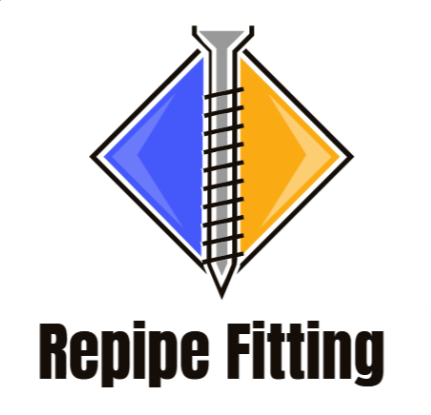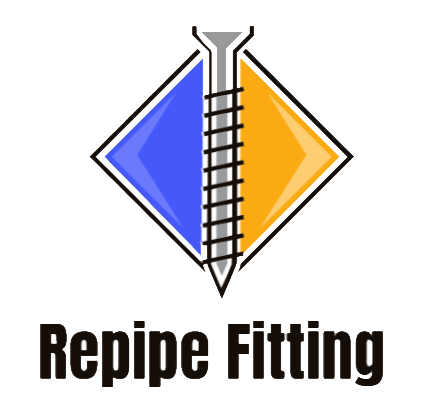Introduction
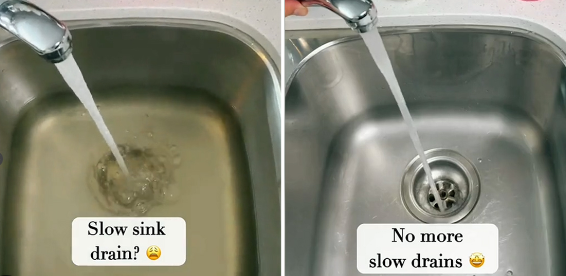
Ah, the slow draining kitchen sink – a household nuisance we’ve all faced at one point or another. Picture this: you’re washing dishes, and the water just doesn’t seem to go down. It’s frustrating, isn’t it? This common issue often results from a buildup of everyday materials like grease, food particles, and debris. But fear not! With the right knowledge and tools, you can unclog that kitchen sink drain in no time. In this guide, we’ll delve into the importance of addressing this issue promptly and provide you with tried-and-true methods to get your sink back in tip-top shape.
Brief overview of the common issue of slow-draining kitchen sinks.
Every kitchen sink, whether in New Jersey or elsewhere, faces the challenge of becoming clogged over time. Factors like grease buildup, food accumulation, and the occasional coffee grounds or egg shells that slip down the drain can lead to a slow-draining sink. And while it might seem like a minor inconvenience at first, if left unattended, it can lead to bigger plumbing troubles.
Importance of addressing the issue promptly to avoid further complications.
Ignoring a slow draining kitchen sink can lead to more severe drainage issues. Standing water can become a breeding ground for bacteria, leading to nasty odours. Moreover, the organic waste buildup can corrode your pipes over time. RepipeFitting always recommends addressing these issues promptly to prevent further complications.
1. Understanding the Causes of a Slow Draining Kitchen Sink

Every homeowner has faced the challenge of a slow draining kitchen sink. It’s not just a simple inconvenience; it’s a sign that something is amiss in your drainage system. But what exactly causes this household nuisance? Let’s dive in.
Everyday materials causing blockages: hair, soap, toothpaste, food particles, and grease.
Your kitchen sink sees a lot of action. From washing dishes to rinsing vegetables, it’s a hub of activity. Over time, everyday materials like food particles, grease, and even the occasional fibrous strings from vegetables can accumulate, leading to a clogged kitchen sink drain.
- Hair: While more common in bathroom sinks, hair can sometimes find its way into your kitchen sink, especially if you have pets or wash your hair in the kitchen sink.
- Soap: Over time, soap can leave a residue that, combined with other materials, can cause blockages.
Toothpaste: Another culprit more common in bathroom sinks, but it’s worth mentioning as it can contribute to blockages when combined with hair and soap.
Food Particles: Bits of vegetable peels, coffee grounds, egg shells, and potato peels can get trapped in the drain, especially if you don’t have a kitchen sink garbage disposal or if it’s not working efficiently.
Grease: One of the biggest culprits in the kitchen. When fat cools, it solidifies. Over time, this grease buildup can severely clog your drain.
Differences between bathroom and kitchen sink clogs.
While both sinks can experience clogs, the causes can differ significantly. Bathroom sinks often get clogged due to hair, soap, and toothpaste. These, combined with the occasional debris like fibrous strings from dental floss, can lead to blockages. On the other hand, kitchen sinks deal more with grease, food particles, and the challenges posed by garbage disposals. Understanding these differences can help in choosing the right method to unclog each type of sink.
The role of grease and its solidification in kitchen sinks.
Grease is a sneaky adversary. It might seem harmless when it’s in its liquid form, but as it cools down, it solidifies, leading to grease buildup in your kitchen sink drain. Imagine pouring melted butter into a glass and then placing it in the fridge. It hardens, right? The same happens in your pipes. Over time, this solidified grease can trap food particles, leading to a slow draining sink or even a complete blockage. RepipeFitting often emphasizes the importance of never pouring grease down the drain. Instead, let it cool and dispose of it in the trash.
2. Simple DIY Solutions for a Slow Draining Kitchen Sink
Ah, the dreaded slow draining kitchen sink! We’ve all been there, watching in dismay as the water refuses to go down. But before you call in the cavalry (or RepipeFitting plumber), there are a few DIY solutions you can try. These methods are not only effective but also use everyday materials you likely have on hand.
2.1. The Boiling Water Technique
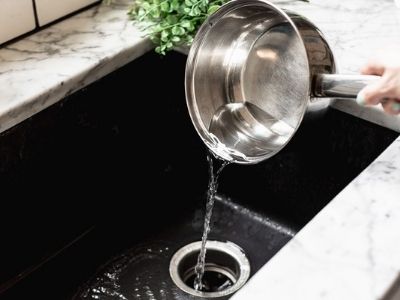
Melting grease with boiling water.
One of the most straightforward methods to tackle a clogged kitchen sink drain is the boiling water technique. Grease buildup is a common culprit behind slow draining sinks. As fat cools, it solidifies, trapping food particles and other debris. Pouring boiling water can melt this grease, allowing it to flow down the drain.
Steps:
- Boil a pot of water.
- Slowly pour the boiling water down the drain, ensuring you don’t splash yourself.
- Turn on the tap to see if the water drains faster.
Using baking soda and white vinegar for added effectiveness.
For an extra punch, you can combine boiling water with the fizz and bubble action of baking soda and white vinegar. This dynamic duo can break down gunk and organic buildup, making it easier to flush away.
Steps:
- Pour half a cup of baking soda down the drain.
- Follow with an equal amount of white vinegar.
- Let the mixture sit for 30 minutes, allowing the fizzing action to break down the blockage.
- Pour boiling water to flush out the mixture and any dislodged debris.
2.2. The Plunger Method
Proper technique for using a plunger to dislodge clogs.
A plunger isn’t just for toilets! With the right technique, it can be a handy tool for unclogging your kitchen sink. The suction created by the plunger can help dislodge blockages, making it one of the most effective Plunger Techniques for sink issues.
Steps:
- Fill the sink with enough water to cover the plunger’s head.
- Place the plunger over the drain, ensuring a good seal.
- Push down and pull up vigorously several times.
- Check the drainage speed and repeat if necessary.
2.3. Natural Drain Cleaners
Combining baking soda and vinegar for a foamy reaction.
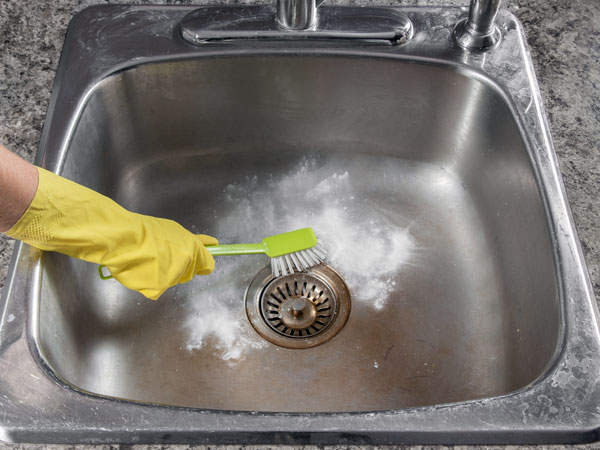
As mentioned earlier, the combination of baking soda and white vinegar can create a powerful foamy reaction that breaks down blockages. This method is not only effective but also environmentally friendly, making it a preferred choice over chemical drain cleaners.
Steps:
- Pour half a cup of baking soda into the drain.
- Add an equal amount of white vinegar.
- Allow the mixture to sit for 30 minutes.
- Rinse with boiling water.
Benefits of using natural solutions over chemical drain cleaners.
While chemical drain cleaners like Drain-O can be effective, they come with a host of issues. They contain harsh chemicals that can be harmful to the environment and may cause burns if they come into contact with the skin. On the other hand, natural solutions are safe, eco-friendly, and just as effective for most clogs.
3. Advanced Techniques for Stubborn Clogs
Sometimes, despite our best efforts, that pesky kitchen sink drain remains stubbornly clogged. When simple DIY solutions don’t do the trick, it’s time to roll up your sleeves and try some advanced techniques. Remember, every plumber, even the experts at RepipeFitting, started as a beginner. With patience and the right tools, you can tackle even the most stubborn of clogs.
3.1. Cleaning the P-Trap
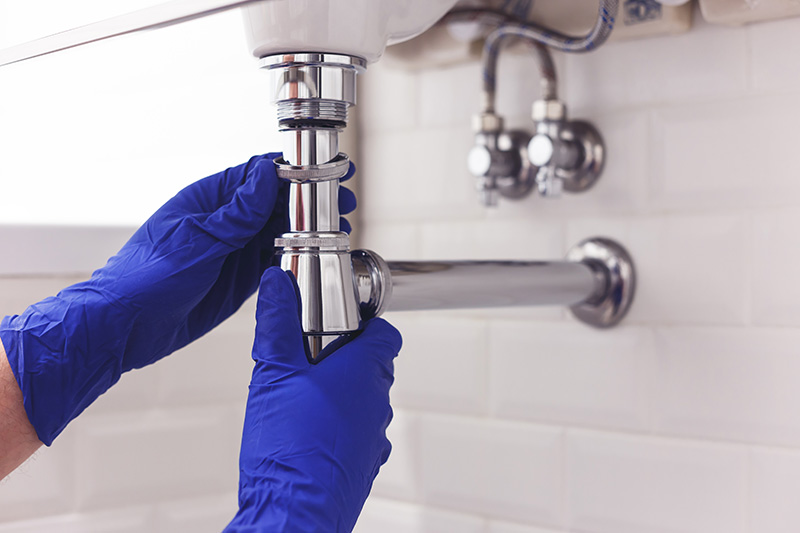
Identifying and removing blockages in the P-trap.
The P-trap is that U-shaped pipe beneath your sink. It’s designed to trap debris and prevent sewer gases from entering your home. Over time, sediments, grease, and food particles can accumulate in the P-trap, leading to blockages.
Signs your P-trap might be clogged:
- Slow draining sink despite trying other methods.
- Nasty odours emanating from the drain.
- Visible gunk or organic buildup when you peek under the sink.
Tools required and the step-by-step process.
Tools:
- Bucket (to catch any water or debris)
- Channel-type pliers or a wrench
- Rubber gloves
- Paper towels or rags
Steps:
- Place the bucket directly under the P-trap.
- Using your channel-type pliers, gently loosen the nuts on both ends of the P-trap.
- Once loosened, remove the P-trap. Water and debris might spill out, so be prepared.
- Inspect the inside of the P-trap. Remove any blockages using your gloves or paper towels.
- Once cleaned, reattach the P-trap, ensuring the nuts are tightened securely.
- Run water through the sink to check if the clog is cleared.
3.2. Using a Drain Snake
When to consider using a drain snake.
A drain snake, or plumber’s auger, is a long, flexible tool that can be manually or mechanically rotated to dislodge blockages deep within your drain pipes. If you’ve tried other methods and the water still isn’t flowing freely, it might be time to consider the Drain Snake Application.
Proper technique for snaking a drain.
Steps:
- Insert the end of the drain snake into the drain.
- Rotate the handle or trigger the mechanical rotation, pushing the snake further into the drain.
- When you feel resistance, you’ve likely reached the blockage. Rotate the snake to help dislodge the clog.
- Slowly pull out the drain snake, bringing the blockage with it.
- Once removed, run water to ensure the drain is clear.
4. Preventative Measures for a Clog-Free Sink
Prevention, as they say, is better than cure. While it’s essential to know how to tackle a clogged kitchen sink drain, it’s even more crucial to understand how to prevent these blockages in the first place. By adopting a few simple habits and regular maintenance, you can ensure your sink remains clog-free and functions optimally.
4.1. Proper Disposal of Grease and Food Particles
The dangers of pouring grease down the sink.
We’ve all been tempted to pour that leftover grease from our frying pan down the sink. However, as the grease cools, it solidifies, leading to grease buildup. This not only slows down your sink but can also trap food particles, creating a perfect recipe for a clog. RepipeFitting often encounters these grease-related blockages, which can be a real household nuisance.
Safe methods for disposing of grease and food waste.
Instead of pouring grease down the drain, consider these safer alternatives:
- Pour the grease into a container, let it solidify, and then dispose of it in the trash.
- Use paper towels to wipe down greasy pans before washing them.
- Install a kitchen sink garbage disposal to grind up food particles, but avoid fibrous strings, coffee grounds, egg shells, and potato peels as they can cause blockages.
- Use a strainer to catch larger food particles and empty it into the trash regularly.
4.2. Regular Maintenance with Enzymes
How enzymes work to prevent organic waste buildup.
Enzymes are nature’s way of breaking down organic waste. Enzyme-based cleaners contain bacteria that feed on the organic buildup in your drains, such as grease, hair, and food particles. As they consume this waste, they produce enzymes that break it down further, preventing blockages.
Benefits of using enzyme-based cleaners.
- Eco-friendly: Unlike harsh chemicals, enzymes are natural and won’t harm the environment.
- Safe for pipes: They won’t corrode or damage your drain pipes.
- Effective: Regular use can prevent organic waste buildup, reducing the chances of clogs.
- Eliminates odours: As they break down waste, they also tackle nasty odours, leaving your sink smelling fresh.
5. What Not to Put Down Your Kitchen Sink
One of the best ways to prevent a clogged kitchen sink drain is by being mindful of what goes down it. While garbage disposals can be handy, they aren’t designed to handle everything. Let’s dive into some everyday materials that can quickly turn your sink into a household nuisance.
Common items that can cause clogs: grease, bones, celery, coffee grounds, egg shells, corn husks, fruit pits, and potato peels.
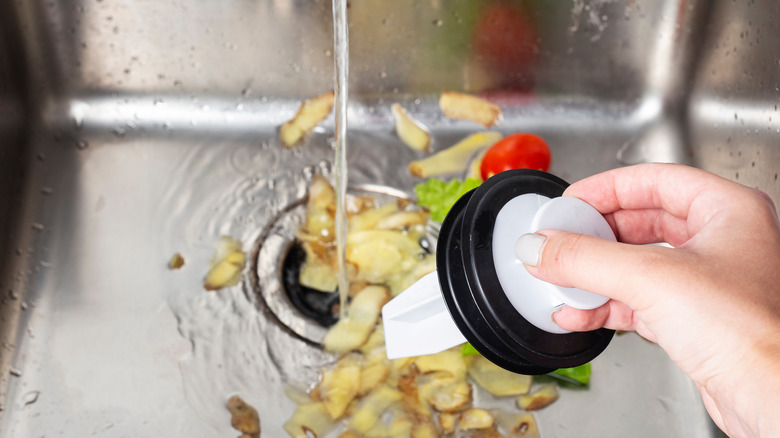
- Grease: As tempting as it might be to pour leftover grease down the sink, remember that as fat cools, it solidifies. This grease buildup can trap other food particles, leading to blockages.
- Coffee Grounds: These can accumulate in your drain, causing slow draining sinks. Instead, consider adding them to your compost or trash.
Egg Shells: The thin membrane can wrap around your garbage disposal blades, and the ground-up shell creates a thick paste that can clog your drain.
- Vegetable Peels: Items like potato peels can become a starchy mess in your disposal. It’s best to dispose of them in the trash or compost.
- Bones and Fruit Pits: These are too hard for garbage disposals to handle and can lead to damage or blockages.
Remember, prevention is the first step in maintaining a clog-free sink. By being cautious of what goes down your drain, you can save yourself from future plumbing troubles.
6. Recognizing When to Call a Professional
While DIY solutions can be effective for minor clogs, sometimes the blockage is a symptom of a more significant issue. Recognizing when to call in the experts can save you time, money, and further complications.
Signs that indicate a more serious underlying issue.
- Persistent Clogs: If you’ve tried multiple methods and the clog keeps returning, it might be deeper in the drainage system.
- Multiple Clogged Drains: If more than one drain in your home is clogged, this could indicate a problem with your main sewer line.
- Foul Odors: Nasty odours emanating from your drain can be a sign of a blockage or a sewer line issue.
- Water Backup: If water backs up in other places, like when flushing a toilet, it’s a clear sign of a drainage system issue.
Potential sewer line problems and their implications.
Sewer line problems can be caused by various issues, from tree roots infiltrating the pipes to a buildup of debris and sediments. If left unaddressed, these can lead to significant plumbing problems and potential health hazards. It’s essential to consult with a qualified plumber, like a RepipeFitting plumber, to diagnose and address these issues.
Ah, the journey of understanding the intricacies of a slow draining kitchen sink! It’s been quite the ride, hasn’t it? Let’s take a moment to reflect on what we’ve learned and the importance of maintaining a clog-free sink.
Recap of the importance of maintaining a clog-free sink.
Your kitchen sink is more than just a basin; it’s a workhorse that sees a lot of action. From washing dishes to rinsing vegetables, it plays a pivotal role in your daily life. A clogged kitchen sink drain can disrupt your routine, leading to standing water and unpleasant odours. By understanding the common culprits, like grease buildup and everyday materials such as hair and food particles, you can take proactive steps to prevent blockages. Remember, prevention is always better than cure!
Encouragement for regular maintenance and timely interventions.
Consistent maintenance is the key to a smoothly functioning sink. Whether it’s the simple act of running boiling water down the drain or using a mixture of vinegar and baking soda to fizz and bubble away gunk, these small actions can make a big difference. And if you ever find yourself in a tight spot with a stubborn blockage, don’t hesitate to call a qualified plumber or seek professional plumbing services. Your sink, and your sanity, will thank you!
FAQ:
Q1: How often should I clean my kitchen sink drain to prevent slow drainage?
drainage?
Answer: Ideally, you should give your kitchen sink drain a quick clean once a week. This can be as simple as running boiling water down the drain to melt away any grease buildup. For a deeper clean, consider using a mixture of baking soda and white vinegar once a month. This not only helps unclog minor blockages but also keeps nasty odors at bay.
Q2: Are chemical drain cleaners safe for my pipes?
Answer: While chemical drain cleaners can be effective in dissolving blockages, they come with risks. Harsh chemicals can corrode older pipes, leading to leaks and further plumbing troubles. Moreover, they’re not environmentally friendly and can harm aquatic life if they find their way into waterways. It’s always best to start with natural solutions like baking soda and vinegar or enzyme-based cleaners before resorting to chemicals.
Q3: What are the signs that indicate a potential sewer line issue?
Answer: Persistent clogs, multiple drains backing up simultaneously, and foul odours emanating from your drains are red flags. Additionally, if you hear gurgling sounds from your drains or toilets, it might indicate a sewer line problem. In such cases, it’s crucial to consult with a professional, such as a RepipeFitting plumber, to diagnose and address the issue.
